Did you know that Kalanchoe delagoensis, also known as the Chandelier Plant or Mother of Millions, is not only a beautiful succulent but also a prolific plant that can produce up to 1,000 plantlets in a single season? This fascinating succulent, native to Madagascar, has captured the attention of avid gardeners and succulent enthusiasts worldwide, including the United Kingdom.
If you’re looking to add a unique touch to your indoor or outdoor garden, keep reading to discover the essential care tips for Kalanchoe delagoensis in the UK.
Appearance of Kalanchoe delagoensis (Chandelier Plant)

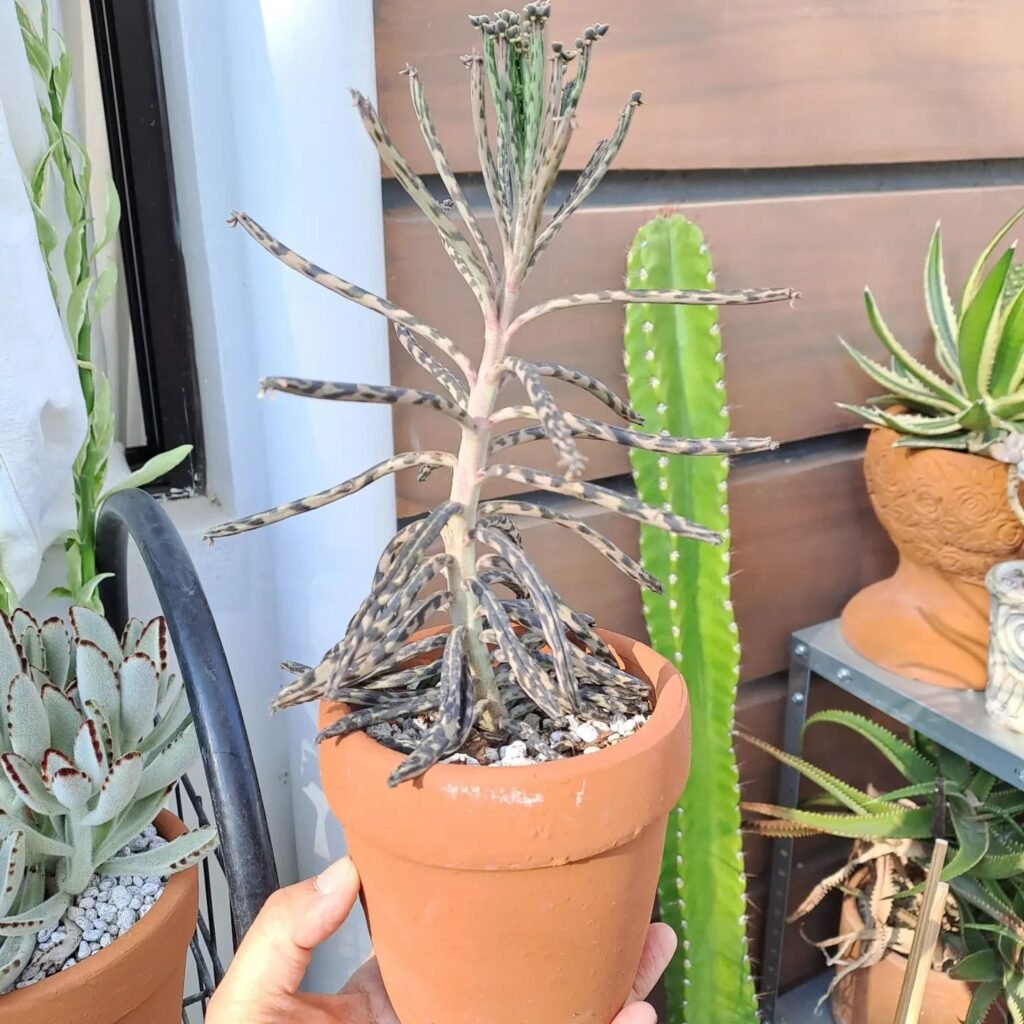
Kalanchoe delagoensis, also known as the Chandelier Plant, is an upright perennial succulent that can reach a height of up to 1 meter. Its unique appearance and distinctive foliage make it a popular choice for indoor and outdoor gardens in the United Kingdom.
The leaves of Kalanchoe delagoensis are almost cylindrical, with a grey-green color and red-brown spots. These spotted leaves add an interesting texture and visual appeal to the plant, making it an attractive addition to any space.
One of the most fascinating features of the Chandelier Plant is its ability to produce plantlets at the tips of its leaves. These plantlets, also known as “chicks,” grow along the edges of the leaves and can eventually develop into new individual plants. This natural propagation process adds a unique charm to the Kalanchoe delagoensis.
In late winter and early spring, the Chandelier Plant produces impressive flowering displays. The flowers appear in panicles, showcasing tubular or bell-shaped blooms in shades of purple-grey to pale orange-yellow. These vibrant blossoms add a splash of color and further enhance the overall appearance of the plant.
If you’re looking to add a visually striking and easy-to-care-for succulent to your garden or indoor collection, Kalanchoe delagoensis is a fantastic choice. Its remarkable appearance, from the cylindrical leaves with red-brown spots to the beautiful flowers, will undoubtedly make it a focal point in any space.
 Did you know the Kalanchoe delagoensis has a unique way of reproducing? It produces tiny plantlets on its leaf margins, which can root and grow independently, making it an incredibly self-sufficient plant.
Did you know the Kalanchoe delagoensis has a unique way of reproducing? It produces tiny plantlets on its leaf margins, which can root and grow independently, making it an incredibly self-sufficient plant.
Light requirements for Kalanchoe delagoensis
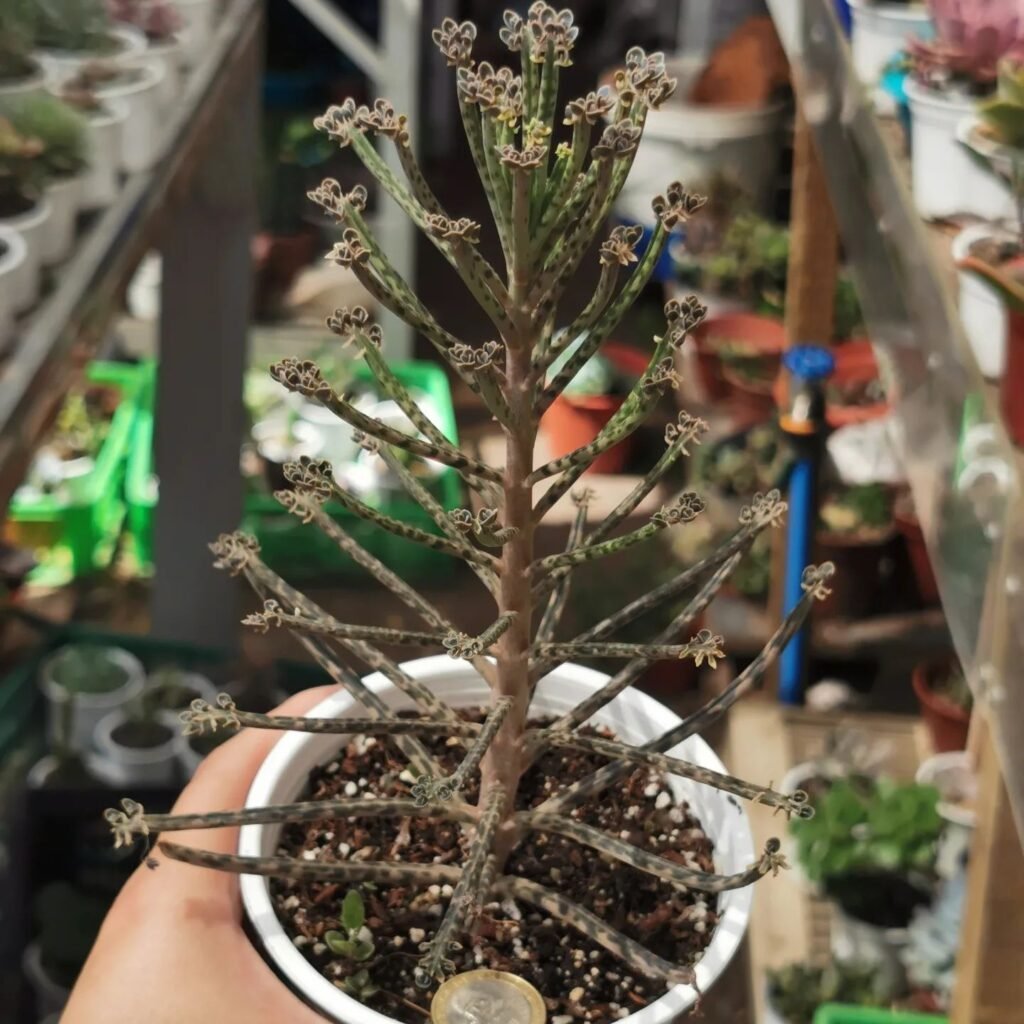
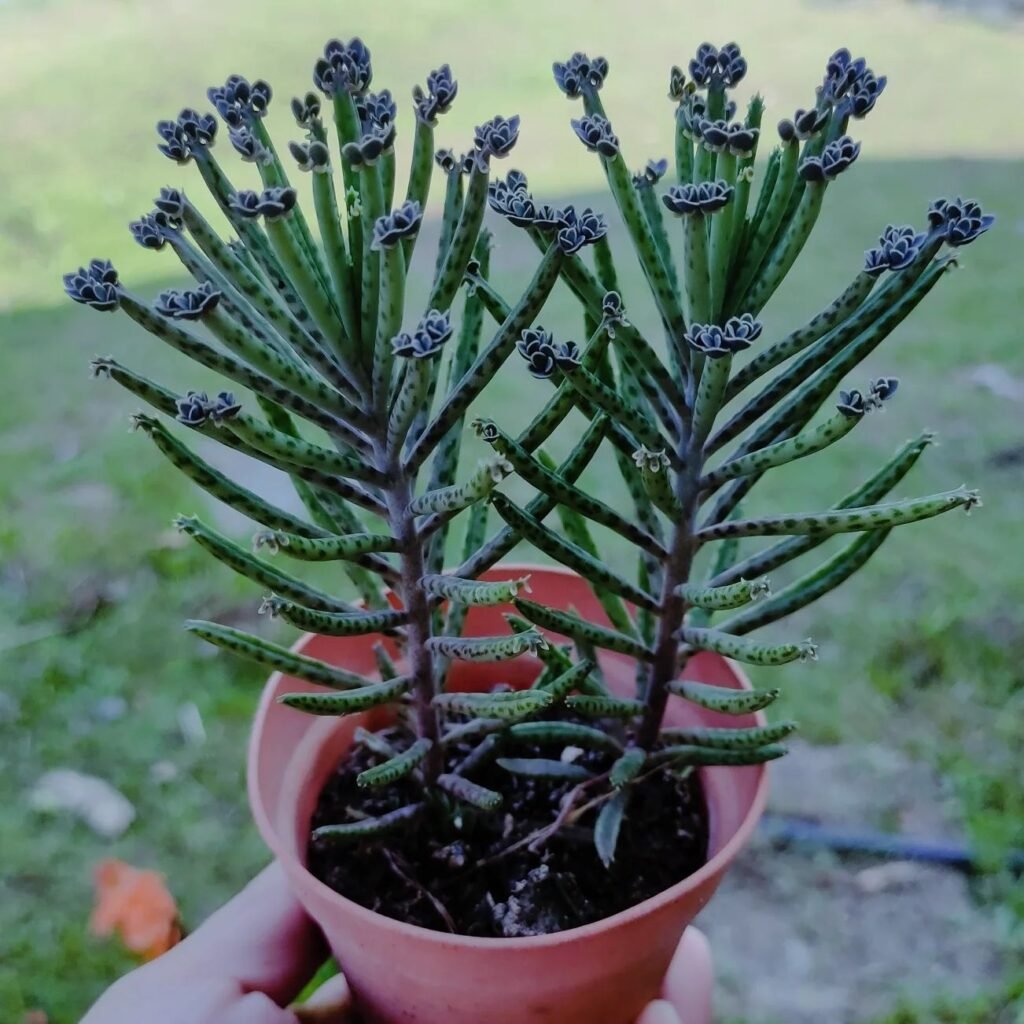
Kalanchoe delagoensis, also known as the Chandelier Plant, has specific light requirements that are crucial for its growth and well-being. Whether you are growing this succulent indoors or outdoors, providing the right amount of sunlight is essential.
When growing Kalanchoe delagoensis outside, it thrives in full sun to partial shade. It prefers a south-facing, west-facing, or east-facing aspect to ensure it receives adequate sunlight exposure. Placing it in these positions will allow the plant to benefit from the optimal balance of light it needs to thrive.
If you are growing Kalanchoe delagoensis indoors, it is best to place it near a bright window that receives plenty of sunlight. A south-facing window is ideal, as it provides the most intense light. However, a west or east-facing window can also work well, as long as the plant receives a good amount of direct or indirect sunlight throughout the day.
It is important to note that while Kalanchoe delagoensis requires a good amount of light, it is also sensitive to extremely low light conditions. Avoid placing it in areas of your home with limited natural light, as this can hinder its growth and overall health.

Watering tips for Kalanchoe delagoensis (Chandelier Plant)


When it comes to watering your Kalanchoe delagoensis, it’s important to find the right balance. This succulent prefers to be under-watered rather than over-watered, so allowing the soil to dry out between waterings is crucial. Here are some watering tips to keep your Chandelier Plant healthy and thriving:
- Water moderately throughout the year, ensuring that the water penetrates the soil evenly.
- Avoid overwatering, as it can lead to root rot and other moisture-related issues.
- Reduce watering frequency during the winter months, when the plant is in a dormant phase. Let the soil dry out more between waterings, but be careful not to let it completely dry out.
- Check the soil moisture level before watering. Stick your finger about an inch into the soil, and if it feels dry, it’s time to water. If it’s still moist, wait a few more days.
Kalanchoe delagoensis exhibits good drought tolerance, thanks to its succulent nature. However, it’s important to provide it with regular moisture to maintain its health. By following these watering tips and finding a watering schedule that works for your plant, you can ensure that your Kalanchoe delagoensis thrives in any environment.

Fertilizing and soil for Kalanchoe delagoensis

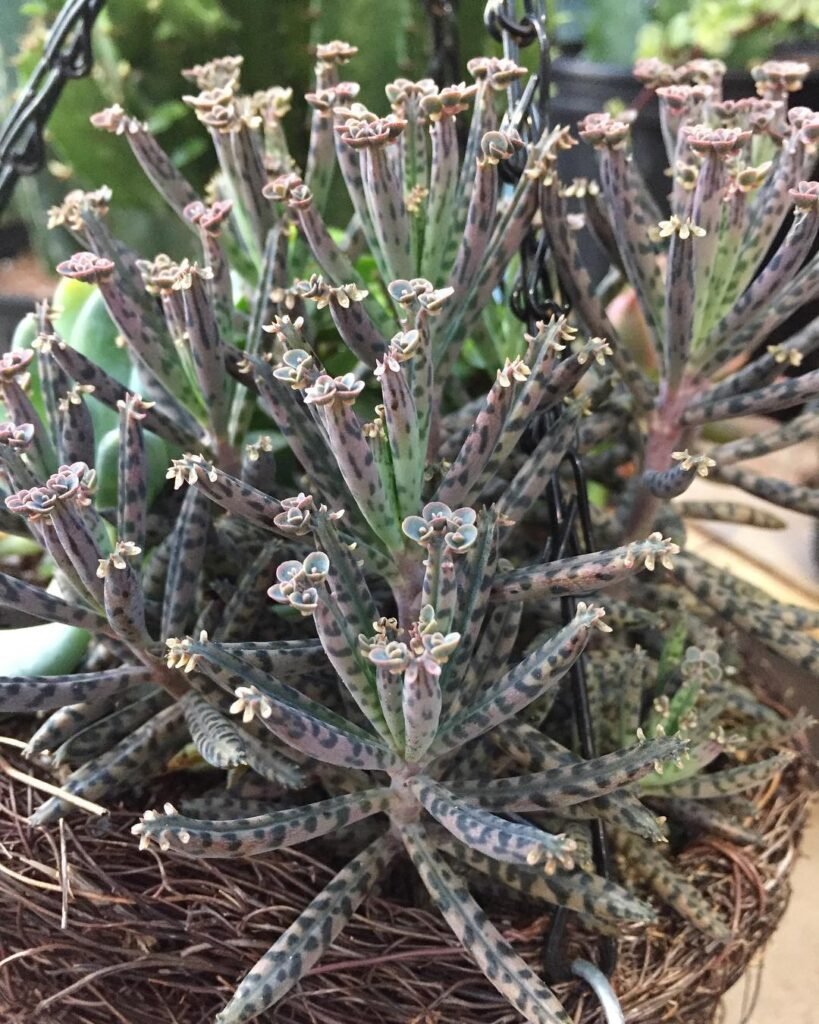
When it comes to caring for your Kalanchoe delagoensis, providing the right fertilizing and soil conditions is crucial for its healthy growth.
First and foremost, it’s important to choose well-drained soil for your Chandelier Plant. Opt for a loam-based potting compost that allows excess water to drain away quickly, preventing root rot. You can further enhance the drainage properties of the soil by mixing in additional perlite or grit.
To ensure your Kalanchoe delagoensis receives an adequate supply of nutrients, it’s essential to fertilize the plant during the growing season. Look for a liquid fertilizer specially formulated for cacti and succulents, as these plants have unique nutritional requirements. Apply the fertilizer 2-3 times throughout the growing season, following the instructions on the label.
Fertilizing your Chandelier Plant with the right nutrients will help promote healthy growth, vibrant foliage, and robust blooms. Remember to always follow the recommended dosage and frequency to avoid overfertilization, which can harm the plant.

Pruning and maintenance for Chandelier Plant

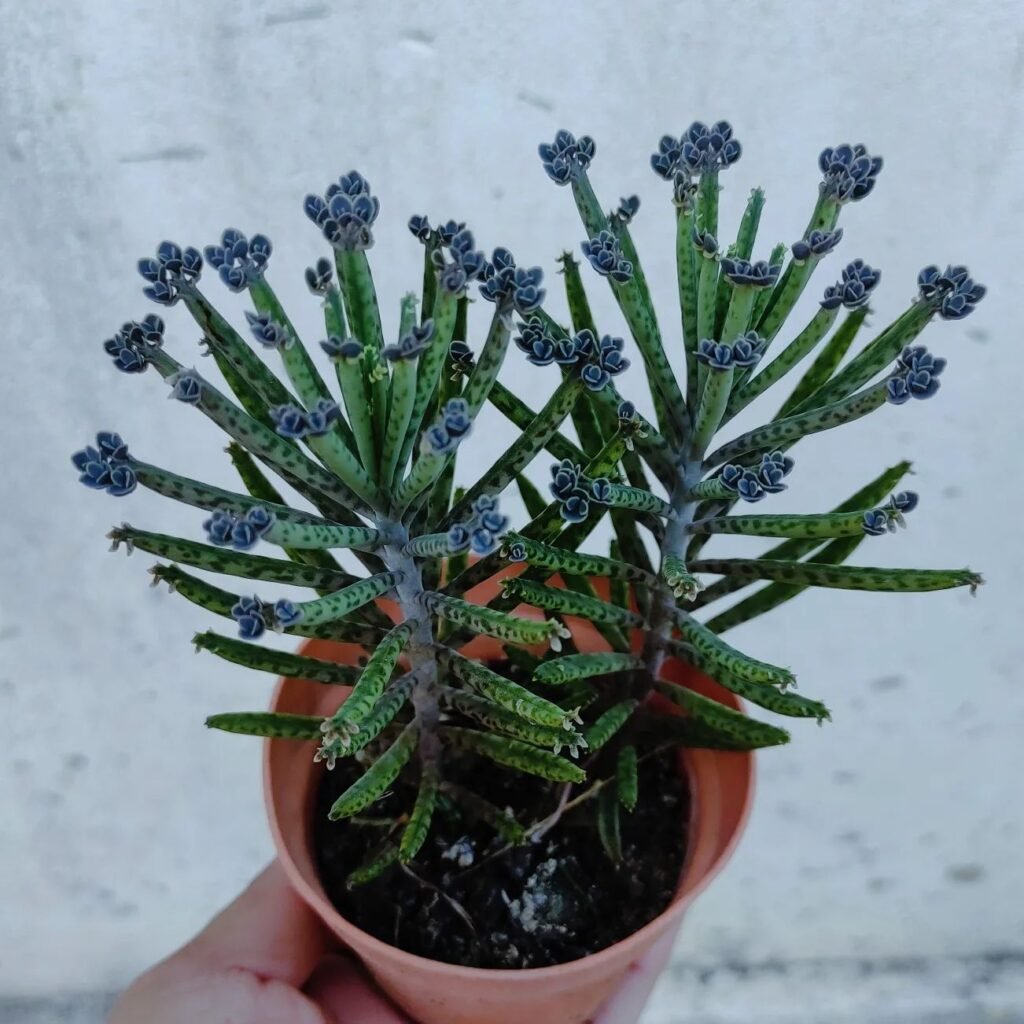
When it comes to pruning and maintenance for Kalanchoe delagoensis, it’s good news – this plant typically does not require much pruning. However, there are a few key things you can do to keep your Chandelier Plant healthy and looking its best.
- Remove yellow or dying leaves: Occasionally, you may notice yellow or dying leaves on your Kalanchoe delagoensis. These leaves can hinder the plant’s growth and appearance. To promote better growth conditions, simply remove any yellow or dying leaves that you come across.
- Clean up plant debris: Another important aspect of maintenance is keeping your plant clean. Remove any plant debris, such as fallen leaves or dead flowers, from the base of the plant. This helps prevent the build-up of moisture, which can lead to fungal diseases.
In addition to pruning, it’s crucial to keep an eye out for pests that may affect the health of your Kalanchoe delagoensis. Mealybugs and aphids are common pests that can infest the plant and cause damage. If you notice signs of pest infestation, you can employ appropriate pest control methods to keep your Chandelier Plant healthy.
Overall, with minimal pruning and regular maintenance, you can ensure that your Kalanchoe delagoensis remains vibrant and flourishing, adding a touch of natural beauty to your indoor or outdoor space.
Propagating Kalanchoe delagoensis (Chandelier Plant)
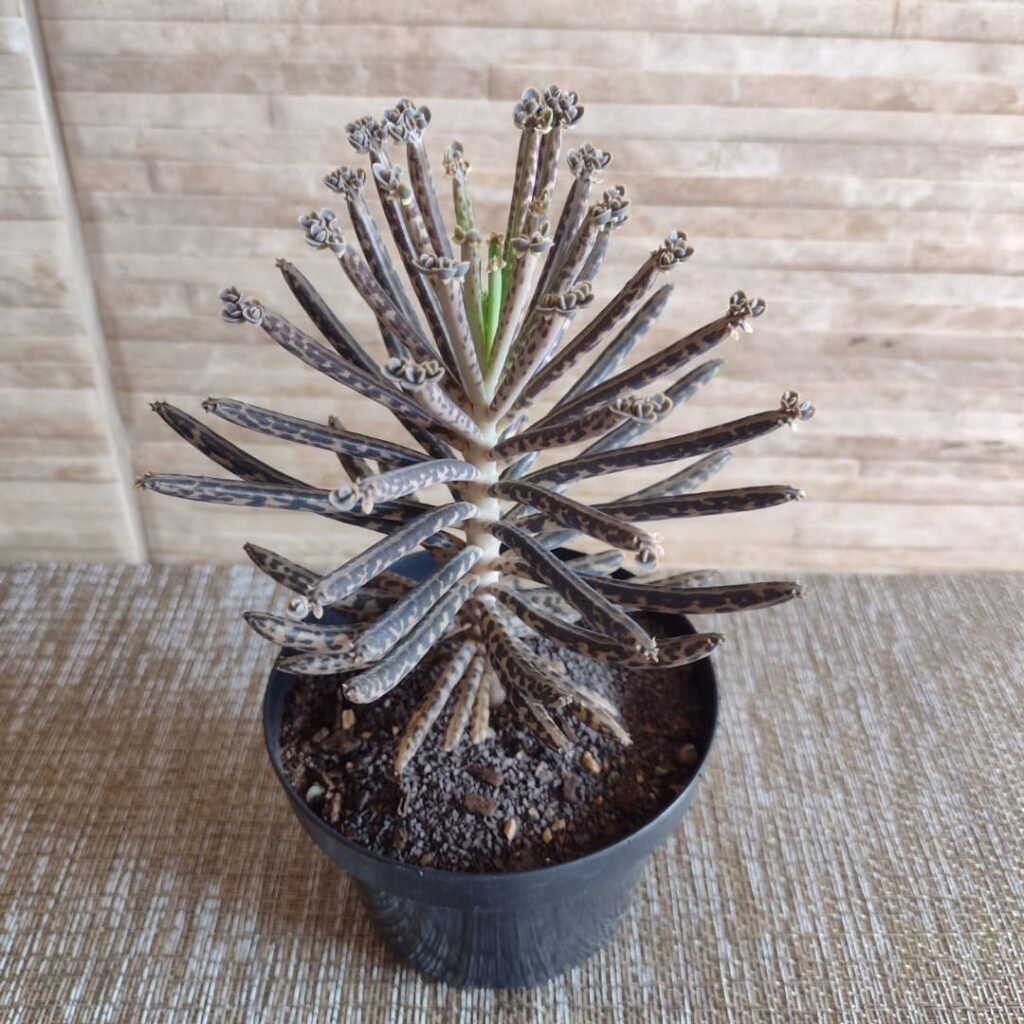
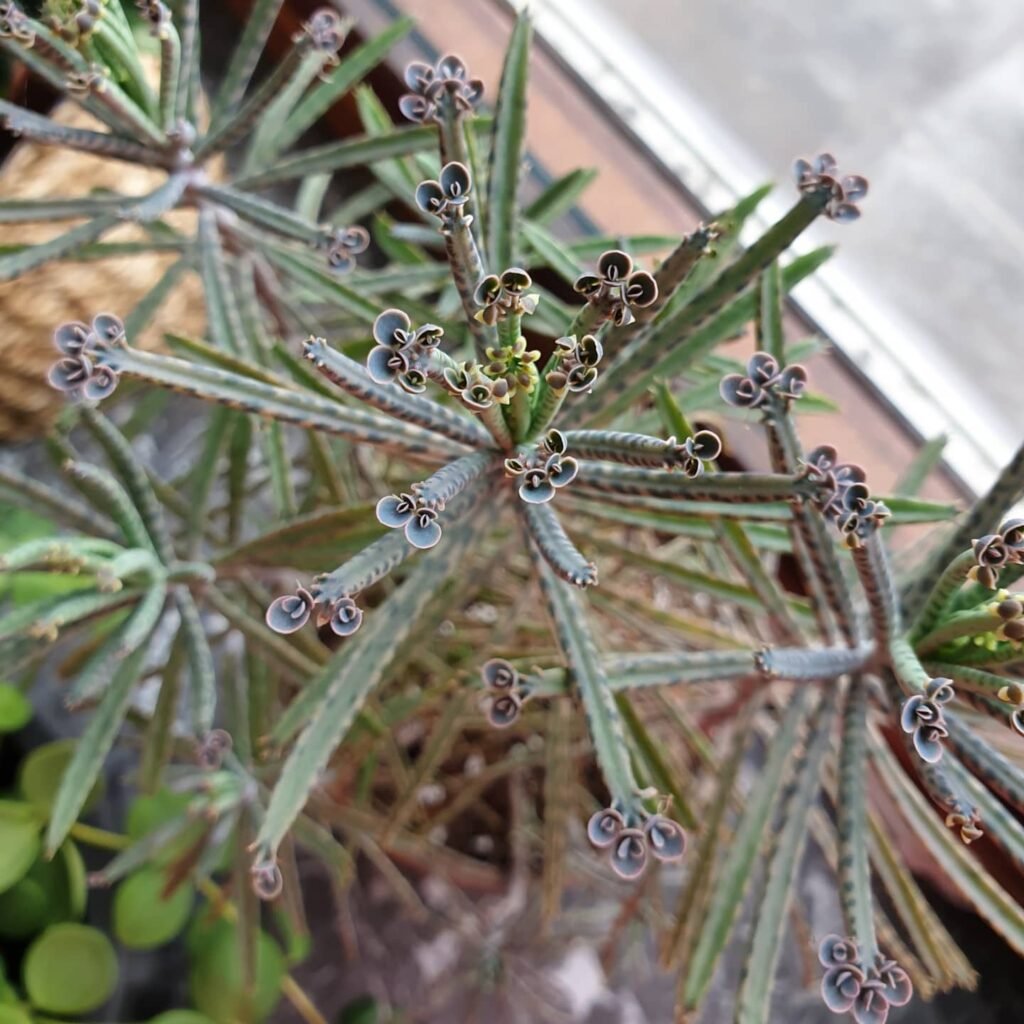
Propagating Kalanchoe delagoensis, also known as the Chandelier Plant, is a simple and rewarding process. There are several methods you can use to propagate this succulent plant.
1. Plantlets
Kalanchoe delagoensis produces plantlets along the edges of its leaves. To propagate using plantlets:
- Gently remove the plantlets from the leaves.
- Place the plantlets on top of moistened soil, ensuring that the roots are in contact with the soil.
- Keep the soil consistently moist, but not soggy, to encourage root growth.
- After a few weeks, the plantlets will develop their own roots and can be potted individually.
This method is particularly effective as the plantlets already have developed roots, making them more likely to establish successfully.
2. Softwood Cuttings
Another way to propagate Kalanchoe delagoensis is through softwood cuttings in spring or summer. Here’s how:
- Select a healthy, young stem from the Chandelier Plant.
- Cut a 4-6 inch section of the stem, ensuring it has at least two sets of leaves.
- Remove the lower leaves to leave a clean stem for planting.
- Allow the cutting to dry and callus for a couple of days.
- Plant the cutting in a well-draining potting mix, burying the bottom half of the stem.
- Place the pot in a location with bright, indirect light.
- Keep the soil lightly moist and mist the cutting occasionally to maintain humidity.
- After a few weeks, roots should start to develop, indicating successful propagation.
3. Seed Propagation
If you prefer to start from scratch, you can propagate Kalanchoe delagoensis from seeds. Here’s how:
- Sow the seeds in early spring in a well-draining potting mix.
- Lightly cover the seeds with a thin layer of soil.
- Keep the soil consistently moist until germination occurs, which usually takes a few weeks.
- Once the seedlings have developed a few sets of leaves, transplant them into individual pots.
While this method takes longer and requires more patience, it can be a rewarding way to start your own Kalanchoe delagoensis plants from scratch.

Repotting tips for Kalanchoe delagoensis (Chandelier Plant)
Repotting is an essential part of caring for your Kalanchoe delagoensis, also known as the Chandelier Plant. Repotting is usually necessary every three to four years to provide the plant with fresh soil and room for growth. Here are some tips to help you successfully repot your Kalanchoe delagoensis:
- Choose the right pot: Select a pot with drainage holes to ensure proper water drainage. A pot made of terracotta or clay is ideal as it allows the soil to breathe.
- Use well-draining potting mix: Use a potting mix specifically labeled for cacti and succulents. This type of mix promotes good drainage and prevents overwatering, which can lead to root rot.
- Keep the plant pot-bound: Kalanchoe delagoensis prefers to be slightly rootbound. This means that you don’t need to choose a pot that is much larger than the current one. A pot that provides a little extra space is sufficient.
- Check for signs of root rot: If you notice any signs of root rot, such as mushy or discolored roots, it’s important to act quickly. Trim away the affected roots and repot the plant in fresh soil to prevent further damage.
- Repot in spring: Spring is the best time to repot Kalanchoe delagoensis as it is entering its active growth phase. This gives the plant enough time to establish new roots and adjust to its new pot before the growing season.
FAQ about Kalanchoe delagoensis (Chandelier Plant)

Puzzled on how to best nurture your Kalanchoe delagoensis (Chandelier Plant)? You’ve landed in just the right place! I’ve compiled all the vital queries to make nurturing your plant straightforward. Whether it’s perfecting your watering regime or overcoming typical challenges, you can count on being well-equipped.
Your Chandelier Plant thrives in bright, indirect sunlight. A spot near an east or west-facing window would be ideal, ensuring it gets the light it needs without the harsh afternoon sun.
Water when the top inch of the soil feels dry. Kalanchoe delagoensis is drought-tolerant, so it’s better to under-water than over-water. During winter, reduce watering frequency as growth slows.
Yes, it prefers well-draining soil. A mix designed for cacti or succulents is perfect, allowing excess water to drain quickly and preventing root rot.
Given the UK’s climate, it’s best kept indoors where you can control its environment. In summer, however, it can be placed outside in a sheltered spot with indirect sunlight.
Easily propagated by cuttings or leaves. Place a cutting or a leaf in soil, and keep it moist until roots develop. This plant can also propagate through tiny plantlets that form on its leaves.
Yellowing leaves, a mushy stem, and dropping leaves are common signs. If you notice these, let the soil dry out completely before watering again lightly.
If the leaves begin to look bleached or have brown crispy edges, it might be getting too much direct sunlight. Move it to a location with indirect, but bright, light.
Feed your Chandelier Plant with a diluted, balanced fertilizer once in spring and once in summer. Avoid feeding in autumn and winter.
Sudden leaf drop can be due to temperature stress, overwatering, or shock from being moved. Check its environment for issues and adjust care accordingly.
Kalanchoe delagoensis does not require high humidity. Average home humidity levels are sufficient for this succulent plant.
Indoors, Kalanchoe delagoensis can reach up to 3 feet tall. Its growth habit is usually vertical, making it a striking addition to indoor spaces.
Repot every 2-3 years or if you notice signs of the plant becoming root-bound. Use a pot just slightly larger than the current one to prevent overwatering.
Be on the lookout for aphids, mealybugs, and spider mites. If pests are spotted, treat with insecticidal soap or neem oil.
Yes, if it’s a bright bathroom. However, ensure it doesn’t stay too humid for the plant, as excessive moisture can harm it.
It’s best kept at temperatures above 10°C (50°F). During cold winter months, keep it away from drafty windows and ensure the room is warm enough.
Yes, it can be toxic if ingested by pets. Keep it out of reach of cats and dogs to prevent any accidents.
Kalanchoe delagoensis is unique because it produces tiny plantlets along the edges of its leaves. These can be gently removed and placed on top of moist soil to grow new plants. This unique propagation method is not only efficient but also quite fascinating to observe.
Absolutely! Due to its unique growing habits and the way it cascades as it matures, Kalanchoe delagoensis is an excellent choice for a hanging basket. This allows the plantlets and trailing stems to dangle beautifully over the sides.
I hope this FAQ has made things clearer on how to look after your Kalanchoe delagoensis (Chandelier Plant). If you’ve got any more questions, feel free to drop them in the comments. I’m here to help. Remember, we all start as novices in gardening, and there’s always something new to learn as you grow your green friend.
Summary
Kalanchoe delagoensis, also known as the Chandelier Plant or Mother of Millions, requires specific care to thrive in the UK. To ensure the health and vibrancy of your Kalanchoe delagoensis, it is important to provide the right light conditions, water the plant moderately, use well-draining soil, and fertilize appropriately. Pruning, propagating, and repotting are also important aspects of care for this unique succulent plant. With its striking appearance and ease of propagation, the Kalanchoe delagoensis is a fantastic addition to both indoor and outdoor gardens in the United Kingdom.
For successful care of your Kalanchoe delagoensis, ensure it receives adequate light. Whether grown indoors or outdoors, position the plant in a location that provides full sun to partial shade. Avoid extremely low light conditions to prevent potential problems.
Proper watering is crucial for the well-being of your Chandelier Plant. Allow the soil to dry out between waterings, and avoid over-watering. Moderation is key, especially during the winter months when watering frequency should be reduced. Remember, Kalanchoe delagoensis has good drought tolerance, but be careful not to let it completely dry out.






